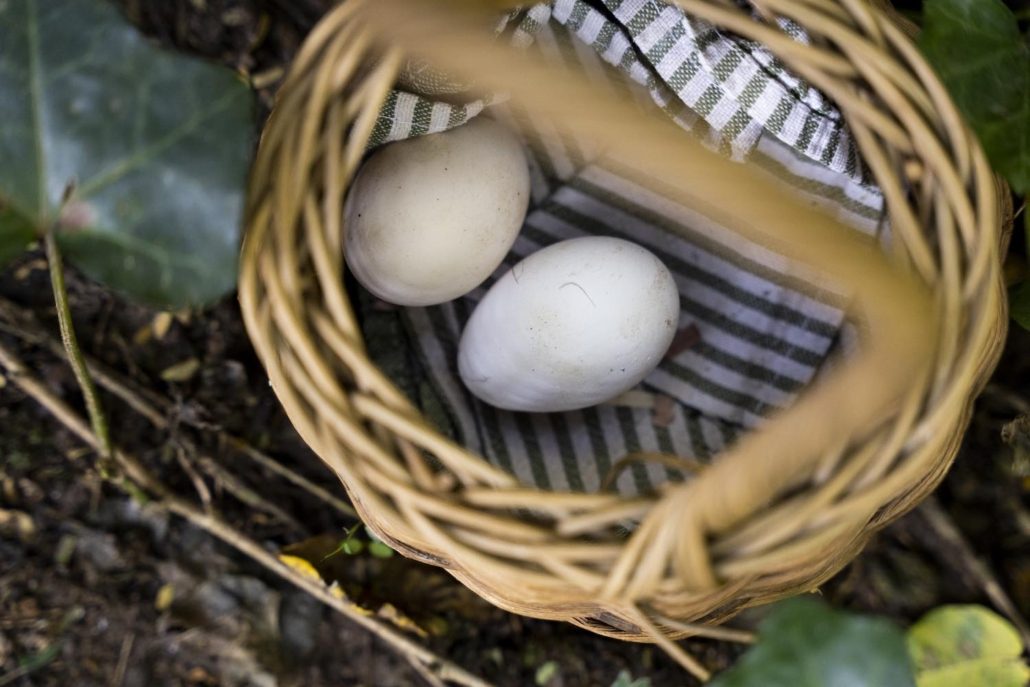GREAT EGGSPECTATIONS
A Primer on Home Chicken-Keeping
The second installment in a three-part series that explores popular homesteading skills.
…
BY ASHLEY ENGLISH | PHOTOS BY ERIN ADAMS
Chickens offer a wealth of joys, from supplying eggs and fertilizer to being organized for mobile units on insect patrol. But, as with any form of animal stewardship, there are a number of things worth considering in advance of acquiring a flock of fine-feathered friends.
First Things To Consider
- As with any pet, keeping chickens will require some commitment of time on your part. Creating the early infrastructure (like housing) for your flock incurs the biggest time investment. After that, it’s simply a matter of daily feeding, hygiene, and safety maintenance. While the amount of time you spend caring for your birds may be small, it will have to happen every day, as well as every evening when you lock them up in the henhouse for the night. Make sure you’re in a position to be able to provide that time.
- In addition to investing your time, you should know that you’ll also be putting out money. I like to tell folks that they can be as palatial or as humble with their flock’s housing as they’d like to be—which is to say, your costs can be grand or small. Either way, some money will need to be spent in either building or buying a coop and run, so bear that in mind when deciding if keeping chickens is right for you.
- Think ahead about who will care for your flock in your absence. Always have a “chicken ace in the hole.” If you go out of town or get stuck away from home when the sun goes down (and the predators come out!), determine in advance who could care for your flock when you’re not around.
- Consider your climate, and choose your chicken breeds accordingly. Breeds that thrive in Maine may not necessarily do well in Miami. Large birds could suffer in hot conditions, while pint-sized breeds are more susceptible to frostbite. In advance of purchasing birds, read up on the breeds that do well in your specific climate. Fortunately, here in Western North Carolina, where the four seasons are mostly moderate, all breeds are worthy of consideration.
- Give thought to the amount of space you’ll need. Chickens require at least two square feet per bird if they have access to a run, and four square feet per bird if they are intensively confined. Make sure to provide those amounts, at the very least, right from the beginning. Failing to do so encourages bad behaviors from distressed birds, like pecking and even, in some worst case scenarios, cannibalism.
- Also, before you get attached to the idea of happy clucking and bountiful eggs, make sure to examine your local codes and ordinances. Statutes on what’s allowed in the world of backyard chicken-keeping vary enormously from city to city and even within neighborhoods (particularly those with homeowners associations). Find out what’s permitted where you live and do all you can to remain in compliance. The city of Asheville, while very friendly to backyard chickens, does require those living within city limits to follow a few guidelines and register an animal permit with the city (go to ashevillenc.gov/service/ get-an-animal-permit/ for additional information and to complete a permit).
- If you’re in the city, know that roosters are prohibited. Roosters crow all day long, at any time. Which is why they’re not allowed in most cities, including Asheville. Keep this in mind if you’re ordering chicks online or by phone, and be certain to request “sexed” birds. In the event, however, that “Sally” turns out to be “Steve”, rehouse your fella as soon as possible. Craigslist is helpful for this purpose, I’ve discovered.
- It might be worth making your neighbors aware of your plans. As I like to say, an ounce of prevention is worth a dozen eggs. While you don’t necessarily need your neighbor’s permission to keep a flock of laying hens, their blessing—or at least their knowledge of your plans—certainly doesn’t hurt. Let them know your intentions and convey that you’ve read up on the topic and intend to stay on top of coop hygiene.
- Give some thought to your existing pets, as well as how your children or other people’s children might interact with the flock. While some dogs couldn’t care less about your birds, others welcome the occasion to have an easy chicken dinner. If you have dogs, watch their behavior when you first bring the chickens home and make decisions about mixing their company accordingly. Children, on the other hand, typically adore chickens and want to play with them all the time. Which is great, but is also why you should pay scrupulous attention to hygiene with little ones. Set aside a pair of “chicken boots” just for the coop area and teach the importance of hand-washing immediately after handling the birds.
Selecting and Obtaining Your Birds
Begin by determining the number of hens you’ll need. Depending on the reason you’re keeping chickens, you may need as few as two or three or you may need 25. If you’re a family of four raising birds for table (that is, to eat), you may need more than if you’re single and wanting a few eggs every other day. Chickens in their high-laying years between ages 1-3 will typically lay one egg every 25 hours. Consider your specific needs, do the math, and plan accordingly.
After you know how many birds you’ll need, choose a breed that suits your purposes. Just like a Labrador Retriever thrives in a family setting, while an Afghan Hound prefers a quieter environment, chicken breeds are known for various qualities. If you’re looking for a heavy layer because your household eats a lot of eggs, seek out birds known for that trait. Some examples include Anconas, Araucana, Black Sex Link, Leghorn, Minorcas, and Red Sex Link.
Alternatively, if you’re looking to raise subsequent generations, you want a breed known for broodiness (that is, the inclination to “go broody” and sit on a group of eggs for hatching). Among the breeds good for that purpose are Silkies, Cochins, Orpingtons, Brahmas, and Australorps.
Once you’ve determined the number and breeds of hens that best suit your needs, it’s time to obtain your birds. Fortunately, getting chickens these days is easier than ever, owing to the explosive interest in backyard chicken-keeping. Look online for suppliers, in publications like Craigslist, or in local classifieds ads. Here in Western North Carolina, there are also a number of active Facebook chicken-keeping groups. You can also often find chicks for sale at farm supply stores and some nurseries in spring and autumn.

Housing Your Flock
Again, you can go for the gold and purchase a premium, premade coop, or cobble something together out of scrap wood you may already have on hand. That’s entirely at your discretion. Either way, be sure to have their housing ready to go before you bring your flock home. You want them to be safe and secure from day one, so do your homework and be prepared to properly steward your new wards.
As with any housing, it’s all about location, location, location. Place your coop in a south-facing area to allow ample sunlight for egg laying (chickens get their cues to lay eggs from the amount of sunlight they receive) and also to help keep the coop and run stay dry. If possible, also site the housing in a location with a slight incline so water (in the form of rain or melting snow) moves away from the coop and run.
You’ll need to provide roosts and nesting boxes for your flock. Modern domesticated chickens are descended from wild Asian jungle fowl, and accordingly, they feel much safer at night up off the ground, away from predatory threats. Wooden roosts are best (avoid plastic or metal as hens need traction for proper gripping). Roost diameter should be one inch for bantams (these are miniaturized chicken breeds — think the poultry equivalent of miniature poodles) and two inches for standard-size chickens. Allow eight inches of roost per bird for bantams and lightweight breeds and 10 inches per bird for heavy breeds.
Also, take care to predator-proof the coop. Many other living creatures are just as interested in fresh eggs and a chicken dinner as you are. Threats come from above, below, and in between (the cracks and the fence, that is!). Use metal hardware cloth as covering for open ventilation areas of the coop, and enclose the run in heavy-duty yard or livestock fencing with holes ideally no larger than 1-inch. Definitely avoid so-called “chicken wire,” which is terribly flimsy and insecure.
Health and Wellness
It’s crucial that you offer dust bath access to your flock. Dust baths are much more than a means for your birds to get down and dirty. When you see your fine-feathered friends looking limp in a dirty hole they scratched out themselves, fear not. This messy act is actually a self-serving one. The dust and dirt clog their pores, which in turn kills parasites such as mites.
If your coop doesn’t have access to dirt, provide it by filling a terra cotta pot or a clean, new cat litter basin with dirt and sand. Be sure to purchase age- and purpose-appropriate feed, feeders, and waterers. Your flock will have different food and equipment needs at different stages in their lives. If you have chicks, they’ll need chick feed and chick-sized waterers and feeders. If you’ve got layers on your hands or broilers, you’ll have to purchase appropriate food for them. Consider the particulars of your situation and purchase what they’ll need to be properly nourished accordingly.
Employ your senses on a daily basis when it comes to managing your flock’s health. Each morning, as I let my flock out of their henhouse, I mentally remind myself to “come to my senses,” quite literally. Look for any signs of harm to the coop from predators, at their droppings for indications of distress (the droppings should be firm and white-capped), and at the birds themselves for any discharge from eyes and ears or foot and claw injuries. Listen for any raspy sounds, sneezing, or coughing from your entire flock (respiratory illnesses are often the biggest threat to your birds). Finally, smell the air in the coop. It shouldn’t smell of ammonia, which is an indication there’s not enough ventilation.
Stay on top of coop hygiene. Once a year, you’ll need to do a big, deep clean. That involves removing all of the bedding and hosing everything down with a mixture of 1:1:10 dishwashing liquid, bleach, and water. Scrub the roosts and nesting boxes as well. Throughout the year, change out the bedding regularly, knock droppings off of the roosts whenever you see them, and always keep the feeders and waterers clean. ◊◊
Ashley English is the author of 11 books, including The Essential Book of Homesteading and Southern From Scratch. She also does a good deal of freelance writing and has been featured in a number of major publications. Ashley lives in Candler, NC, with her husband Glenn, two young sons Huxley and Alistair, and a menagerie of animals. She can be found chronicling her adventures in homesteading and beyond atsmallmeasure.com.
Save
Save
Save
Save
Save
Save
Save
Save

The author, Ashley English, at her home in Candler
THE WEEKLY REVEL
Sign up for your free handpicked guide to enjoying life around Asheville.
Available weekly from May to October.





